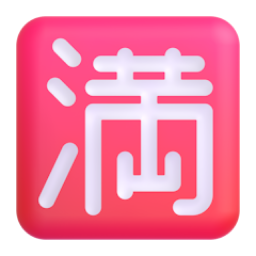🈵 Japanese “no Vacancy” Button Emoji
 Apple
Apple Google
Google Noto Monochrome
Noto Monochrome Fluent UI 3D
Fluent UI 3D Fluent UI Color
Fluent UI Color Fluent UI Flat
Fluent UI Flat Fluent UI High Contrast
Fluent UI High Contrast OpenMoji Color
OpenMoji Color OpenMoji Black
OpenMoji Black Skype
Skype Facebook
Facebook Twitter
Twitter GitHub
GitHub Firefox
Firefox Samsung
Samsung Windows
Windows Gmail
Gmail
More Emojis For You
User Comments
Share Your Comment!
Learn More About 🈵 Japanese “no Vacancy” Button Emoji
🈵 The "no vacancy" button emoji is a popular symbol used in Japan to indicate that a particular space or accommodation is fully booked or unavailable. It is often used in hotels, restaurants, and other service industries to let customers know that there are no more rooms or tables available. This emoji is a convenient and efficient way to communicate this information in a digital format, and it has become a staple in Japanese communication.
How To Use 🈵 Japanese “no Vacancy” Button Emoji
Sorry, all rooms are booked for the weekend. 🈵 (hotel receptionist)
I'm afraid there are no more tickets available for the concert. 🈵 (ticket vendor)
The park is fully booked for the picnic. 🈵 (park ranger)
🈵 Japanese “no Vacancy” Button Emoji Keywords
ideograph, japanese, japanese “no vacancy” button, “no vacancy”, 満
🈵 Japanese “no Vacancy” Button Emoji In Other Languages
Bengali: বর্গাকার পূর্ণতার চিত্রলিপি, Danish: kvadratisk ideogram for optaget, German: Schriftzeichen für „Kein Zimmer frei“, English: Japanese “no vacancy” button, Spanish: ideograma japonés para "completo", Estonian: jaapani nupp "pole vaba", Finnish: täynnä-kirjoitusmerkki, French: bouton complet en japonais, Hindi: जापानी “कोई नौकरी नहीं” बटन, Hungarian: japán „megtelt” gomb, Italian: ideogramma giapponese di “Nessun posto libero”, Japanese: 満マーク, Korean: 찰 만, Lithuanian: pilnatvę reiškiantis hieroglifas, Malay: butang “tiada kekosongan” Jepun, Norwegian Bokmål: «fullt» på japansk, Dutch: Japans teken voor ‘vol, geen plaats’, Polish: japoński przycisk „brak wolnych miejsc”, Portuguese: botão japonês de “sem vagas”, Russian: нет мест, Swedish: japansk ”fullbelagt”-knapp, Thai: ภาษาญี่ปุ่นคำว่า “เต็ม”, Ukrainian: кнопка "місць немає" японською, Chinese: 日文的“没有空位”按钮
